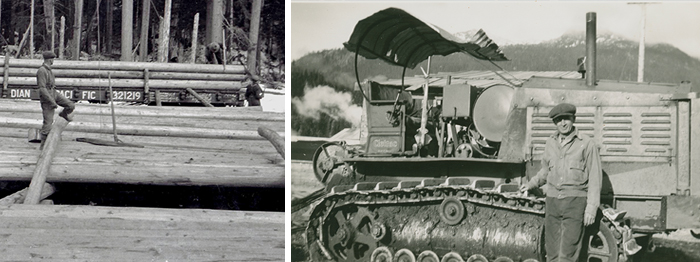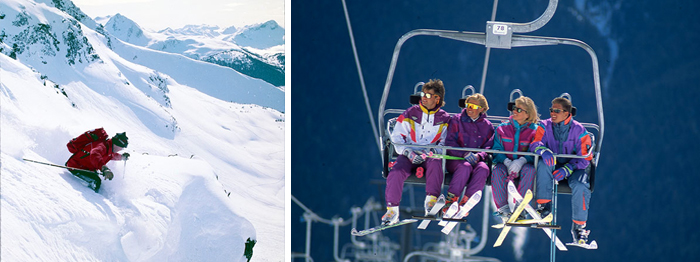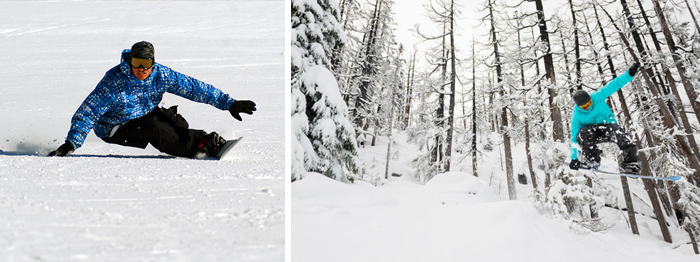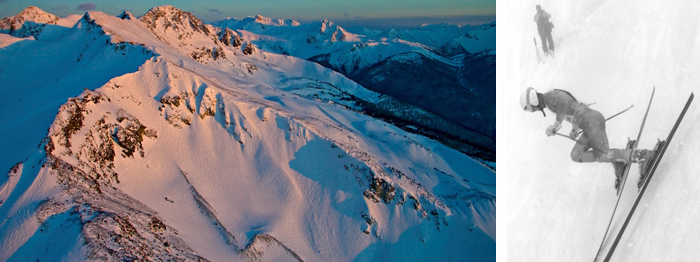
Blackcomb’s original Catskinner chair is still in operation servicing the Terrain Park.
Editor’s Note: Whistler’s excellent Pique Newsmagazine ran a version of this story in December 2014 but The Insider wanted to ensure our global audience also has a chance to learn some of this awesome Whistler history.
Guest Author: Sarah Drewery
For many of us who ski in Whistler — from first time visitors to long-term locals — it’s natural to be curious about the plethora of weird, wonderful and intriguing run names found on both mountains. Thankfully, the Whistler Museum and Archives have been maintaining a database of local lore and run-name stories. Last week we looked at Whistler Mountain so this week it’s an easy ride across the PEAK 2 PEAK Gondola to Blackcomb! Enjoy.
Blackcomb Mountain Ski Run Names
When Blackcomb first opened all the runs were named along a logging theme. This was intended to reflect the logging heritage in the valley. Some of the names are explained below:
Jersey Cream: Extra good timber; cream of the crop.
Stoker: A person employed to fuel the steam engines used to pull the logs.
Hooker: A foreman of a logging “side”. The name was changed as (unsurprisingly) it was not considered politically correct – it is now called Jersey Cream.
Cruiser: A logger who surveys standing timber for volume.
Catskinner: A driver of a machine with caterpillar treads.

LEFT: Logging near the base of Blackcomb, 1920s. RIGHT: A Catskinner, 1930s. Historical photos courtesy THE WHISTLER MUSEUM & ARCHIVES.
The Bite: an area in the curve or slack of a cable. When the cable pulls a log, the slack snaps out causing this area to be very dangerous.
Cougar Milk: A term referring to the grease used on logging equipment.
Undercut: A notch made in the tree to make sure it falls in the desired direction.
Skidder: any type of heavy vehicle used in a logging operation for pulling cut trees out of a forest in a process called “skidding”.
Springboard: A board that hand fallers stood on above the broad base when felling a large tree.
Choker: A short length of wire rope used to wrap around the log to be yarded to the landing.
Gearjammer: A nickname given to a heavy equipment operator.
School Marm: A tree stem that branches into two or more trunks or tops.
Gandy Dancer: A term used for early railroad workers who laid and maintained railroad tracks in the years before the work was done by machines. A worker would lift his gandy (a long handled tool) and force it into the ballast to create a fulcrum, then throw himself sideways using the gandy to check his full weight so the gandy would push the rail toward the inside of the curve.
As Blackcomb grew and matured through the 1980s the mountain created its own stories and characters worthy of run names:
Xhiggy’s Meadow
Named after Peter Xhignesse. ‘Xhiggy’ worked on ski patrol from when Blackcomb first opened in 1980 and was quickly promoted to be the first avalanche forecaster for Blackcomb Mountain. He was extremely dedicated to his job and made sure every step possible was taken to ensure the safety of staff and guests. Sadly, he was claimed by cancer at the young age of 33. Even in his last few days of life he still made sure to spend hours educating his successor on running ski patrol. Arthur DeJong remembers him with great respect: “He drove excellence amongst ski patrol…he defined responsibility to me. When I hit a real challenge I think of Xhiggy, giving his all.” There is a plaque commemorating Peter Xhignesse on Blackcomb Mountain.

LEFT: Peter Xhignesse enjoying some Blackcomb pow. RIGHT: 7th Heaven Express, 1991. COURTESY WHISTLER MUSEUM & ARCHIVES.
7th Heaven
Blackcomb President Hugh Smythe named the area in 1985. “The 7th Heaven T-bar was the 7th lift built on Blackcomb,” he explains, “making 7th Heaven a really appropriate name that reflected the outstanding ski experience of that highest region of the mountain.”
Hugh thought of the name because of an experience he’d had as a young man. He was skiing in Stevens Pass in Washington on a really dreadful day around 1964. The snow was terrible: “When it hit you it sort of knocked you over”. As he got to the top of the chairlift the lift operator came out of the shack, a bearded man with a deep voice, and said: “Welcome to 7th heaven”. Years later that lifty’s words came back to Smythe when naming 7th Heaven. The original T-Bar was replaced in 1987 by the 7th Heaven Express.
Arthur’s Choice
Arthur DeJong started working for Blackcomb Mountain as a ski patroller when the ski hill first opened, in 1980. At that time the Crystal Chair was not yet built and so the areas around the Crystal Zone were outside Blackcomb’s ski boundaries. These prime skiing areas with their fine treed powder runs did not go unnoticed or unappreciated by Blackcomb Ski Patrol. DeJong remembers fondly how, “we knew there was great skiing out there for a long time”.
The Crystal Chair opened in 1989. This coincided with a changing attitude of the next generation of skiers and snowboarders who were growing more adventurous than their predecessors. Skiing in the trees became popular and more and more people started to enjoy it. Unfortunately, the danger of tree wells is very real, especially when the forest is dense. Blackcomb Mountain needed to make a decision: were they going to try to discourage tree skiing (which probably wouldn’t work) or would they make efforts to make tree skiing safer?
Their answer was to introduce gladed skiing, which gave the guest a much safer option of tree skiing. DeJong, who was by now Blackcomb’s Mountain Manager, led the new policy of glading. When the work had been done, the Marketing Director at the time, David Barry, asked DeJong to pick his favourite of the new gladed areas. He selected a particular run because he knew the Whistler kids would love it; a gladed run with plenty of features and character, which was both challenging and fun. Barry therefore proclaimed that the run should be called “Arthur’s Choice”.
Another fun fact relating to these new glades, was that there was a small amount of revenue generated from selling the lumber from the thinned forests. This money was put towards building the first alpine hiking trails on Blackcomb on the south side of 7th Heaven.

LEFT: Ross Rebagliati. COURTESY WHISTLER MUSEUM & ARCHIVES. RIGHT: Arthur’s Choice features primo gladed-run pow in the Crystal Ridge zone.
Ross’ Gold
Named after Ross Rebagliati who grew up in North Vancouver but called Whistler his home for over a decade. Ross was a snowboarder who won a gold medal at 1998 Winter Olympics in Nagano, Japan. As this was the first Olympic snowboard event Ross was the first Olympic gold medalist snowboarder in history. He was presented with a lifetime pass to Whistler Blackcomb and was able to choose a run to be named after him. He chose “Gandy Dancer” a fast, fall-line speedster with nice healthy rollers.
Bushrat
A technical chute off Chainsaw Ridge, Bushrat was named after John Hetherington who had previously worked on the Whistler Mountain Ski Patrol. Ken Newington, Blackcomb’s first Ski Patrol director named this run for Hetherington soon after the area opened.
Garnet, Diamond, Sapphire & Ruby Bowls
Peter Xhignesse and Hugh O’Reilly named the bowls on the backside of Blackcomb Garnet, Diamond, Sapphire and Ruby. They figured that since they already had a Crystal Ridge these much-more-precious runs deserved more value in their namesakes.
Saudan Couloir / Couloir Extreme
Originally named Saudan Couloir after the early French extreme skier Sylvain Saudan. A very popular extreme ski racing event used to take place in this run in the late ‘80s/ early ‘90s. Unfortunately, Saudan was not pleased with his name being used without permission and Blackcomb subsequently changed the name to Couloir Extreme.

LEFT: Evening light on the Couloir Extreme and Chainsaw Ridge. RIGHT: Jim Thornburn races the 1993 Saudan Couloir Ski Race Extreme. COURTESY WHISTLER MUSEUM & ARCHIVES.
Check out part one of this series — Whistler Ski Run Names — or discover more of Whistler’s history at The Whistler Museum, located next to the library on Main Street. And find everything you need to make a Whistler holiday happen at Whistler.com


